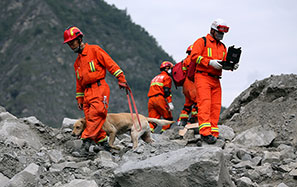Transport capacity expanded to ease pressure on capital
The Beijing municipal government is taking efforts to build a safe, convenient, efficient, green and economic transportation system.
Attaching great importance to solving traffic jams, the capital aims to improve citizens' satisfaction, according to Zhou Zhengyu, the director of the Beijing Municipal Commission of Transport.
Beijing has introduced controls on its population size, transferred some function of capital, optimized the jobhousing balance and reduced commuting distances in order to ease traffic pressure in the last five years, Zhou said.
The municipal government has made financing plans for railways, urban roads and highways, with investment in transportation infrastructure totaling 340 billion yuan ($49.8 billion) between 2012 and 2016. This accounted for 13 percent of fixed-asset investment in Beijing in the period. Public transportation investment accounts for 75 percent of Beijing's total transportation infrastructure investment.
With the support of investment, the capital has accelerated the construction of transportation infrastructure to upgrade capacity.
The length of the urban rail network increased from 372 kilometers to 574 km from 2012 to 2016. During the same period, the city's road length increased from 6,258 km to 6,374 km, with highways extending from 912 km to 1,014 km and bus lanes increasing from 604 km to 845 km.
Green commuting - traveling by bike or public transport - is becoming increasingly popular, according to BMCT.
The Beijing-Tianjin-Hebei coordinated development strategy is promoting traffic integration, according to Zhou.
The Beijing-Zhangjiakou high-speed railway is a key project for solving the problem of northwest commuting and enhancing the integration of Beijing, Tianjin and Hebei, Zhou added.
It will promote coordinated development and support Winter Olympic traffic, because roads linking Beijing and Zhangjiakou - the two co-hosts of the 2022 Winter Olympics - play a major role in transportation between the two cities.
Construction of the Beijing-Bazhou high-speed railway, a key link for the capital's new airport and Xiongan New Area, Hebei province, is planned to kick off in 2020.
The 698-km Beijing-Shenyang high-speed railway starts at Xinghuo Railway Station in Beijing and connects Chengde in Hebei province with Chaoyang and Fuxing in Liaoning province, before eventually reaching Shenyang.
In addition, the one-card-pass project of Beijing, Tianjin and Hebei province, covering 1,011 downtown bus routes and 122 suburb bus routes, makes traffic integration more effective, according to officials.
The Beijing-Kunming Highway, national road 111, Beijing-Taipei expressway and other projects have been put into use, accelerating the connectivity of the regional road network, Zhou said.
These projects will help to relieve the strain on Beijing's non-capital functions to promote the adjustment of the city layout and spacial structure, and to build a modern transportation network with low cost and huge capacity, according to a senior municipal official.
Priority will be given to public transport, which can improve green travel efficiently. Around 850 km of bus lanes, four Bus Rapid Transit lines and 140 direct lines will form a metro-bus public transit system in Beijing, Zhou said.

























